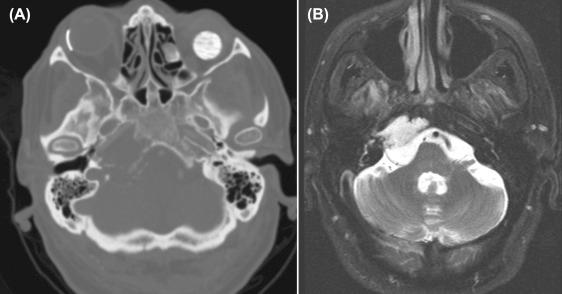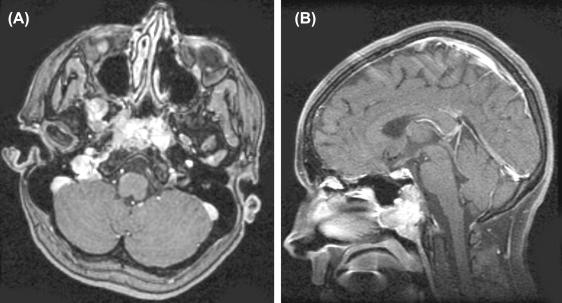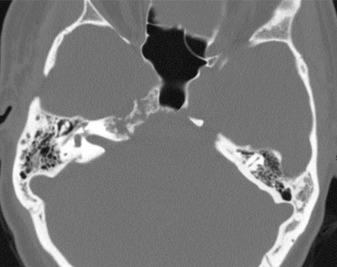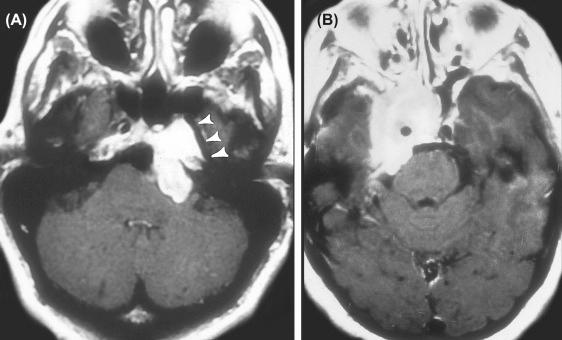Physical Address
304 North Cardinal St.
Dorchester Center, MA 02124
© 2018 Elsevier Inc. All rights reserved. Please note that the copyright for the original figures submitted by the contributors is owned by Contributors.
Skull base chordomas and chondrosarcomas are rare primary bone tumors of the petroclival region that have similar clinical and radiological findings but differ in their treatment response rates and overall outcomes. Skull base chordomas are thought to arise from malignant transformation of notochordal remnants, and thus tend to originate in the midline. Skull base chondrosarcomas typically arise from rests of chondrocytes or pluripotent mesenchymal cells within the petroclival synchondrosis, and thus originate lateral to midline. Both types of lesions tend to grow slowly. Therefore, they may come to clinical attention only after having grown large enough to cause neurological deficits, typically from cranial nerve (most commonly VI) or brainstem compression.
Aggressive total resection of skull base chordomas came into practice with the development of new skull base surgical approaches in hope of extrapolating the modestly favorable results achieved with en bloc resection of spinal chordomas. However, the rigorous en bloc resections, with negative relevant margins and protection of the surgical corridor from surgical seeding, were difficult to reproduce in the skull base. Subsequently, the high recurrence rates that followed total radiographic resections of skull base chordomas prompted a retreat to “maximal safe resection”: that is, aggressive resection without accepting neurologic deficit, followed by regional field adjuvant radiotherapy. In contrast with this treatment of chordoma, for chondrosarcoma, radiotherapy has often been deferred after radiographically complete resection, reflecting the more indolent nature of these tumors. Recent evidence challenges this paradigm by suggesting that outcome might be improved when radiation is added regardless of the extent of chondrosarcoma resection. Notwithstanding the added benefits of radiotherapy, surgery remains the initial and most fundamental treatment for these relatively radioresistant tumors. With the development and refinement of endoscopic endonasal skull base approaches over the past decade, the role of open surgical approaches for chordomas and chondrosarcomas has been correspondingly reduced. Nevertheless, open approaches remain an important tool in the neurosurgical armamentarium, particularly in light of the complex and multicompartmental nature of these tumors. In this chapter, surgical management of skull base chordomas and chondrosarcomas via an open anterolateral approach is reviewed.
Chordomas originate in the midline and are extradural tumors, making them favorable for endoscopic endonasal (transclival) approaches, which allow for direct bilateral ventral access to the epicenter of the tumor without traversing surrounding neurovascular structures. Although chondrosarcomas originate lateral to midline, they are also extradural, tend to be soft and “suckable,” and often displace the surrounding neurovascular structures laterally, superiorly, or posteriorly. Thus, chondrosarcomas are also amenable to endoscopic endonasal (transmaxillary transpterygoid) approaches, which can provide direct access to the petroclival synchondrosis (see Chapter 10, Chapter 12 ).
However, endoscopic endonasal techniques may be less suitable as stand-alone surgical approaches for a chordoma or chondrosarcoma that has significant intradural extension, extends lateral to the carotid artery, and is large (>4 cm or 80 cm 3 ). In such patients, an open surgical approach may offer a better chance to achieve a radical resection or may be combined with an endoscopic approach to achieve a radical resection in cases when either approach alone would result in subtotal resection. The surgical plan should balance reasonable goals for extent of resection with a determination to avoid inflicting new neurologic deficits.
When endoscopic approaches have failed or are deemed to be unfavorable or insufficient for a particular tumor, an open surgical strategy must be devised. This strategy is based on an understanding of the normal and pathologic anatomy and a command of the various surgical approaches necessary to adequately expose and resect the tumor.
Thin-slice skull base MRI and CT scans allow for detailed evaluation of the relevant soft tissue and bony anatomy, respectively. On CT, chordomas are typically well-demarcated, midline, destructive, and hyperdense lesions centered on the clivus. Intratumoral bony sequestra and/or calcification are common findings. On MRI, chordomas are typically hypo-to isointense on T1 and markedly hyperintense on T2 with prominent, heterogeneous enhancement ( Figs. 14.1 and 14.2 ) (see Chapter 6, Chapter 7 ).


On CT, chondrosarcoma appears as a lucent lesion with a sharp nonsclerotic transition zone ( Fig. 14.3 ). Although chondroid matrix calcification (ringlet or incomplete ring) is a key feature of chondrosarcoma, it is seen only in about half of cases. Poorly differentiated chondrosarcomas can be purely lytic without chondroid matrix and can be difficult to differentiate from chordomas. Generally, chondrosarcomas are of intermediate intensity on T1 but are characteristically hyperintense on T2-weighted sequences with moderate and heterogeneous enhancement ( Fig. 14.4 ) (see Chapter 6, Chapter 7 ).


CT or MR angiography can delineate the relationship between the tumor and the carotid/basilar/vertebral arteries by yielding important information on vessel displacement, encasement, and stenosis/occlusion. Unlike parasellar meningiomas, which tend to encase and narrow the carotid artery, petrous apex chondrosarcomas tend to displace it laterally ( Fig. 14.5 ). The high quality and lower risk of contemporary cross-sectional vascular imaging studies obviate the need for formal diagnostic cerebral angiography in most cases. Carotid artery balloon test occlusion is rarely, if ever, necessary because carotid sacrifice is generally neither compatible with the goals of surgery nor within the definition of acceptable risk.

The term gross total resection can be used to describe the surgical impression or the radiographic result after surgery. However, true and complete resection of skull base chordomas is typically not possible for two reasons: first, the limitations imposed by critical surrounding neurovascular structures, and, second, the presence of tumor cell dissemination throughout the bony skull base, which may not be visible radiographically or at surgery. Unlike sacral chordomas for which radical en bloc resection with wide margins is undertaken to improve survival, often at the expense of producing neurologic deficits (including bowel/bladder dysfunction), no such “oncologic” resection is possible for skull base chordomas. In light of the above and in the face of continued improvements in radiation technology/techniques, maximal resection with preservation, rather than sacrifice of neurologic function, is the preferred surgical strategy. The same holds true for skull base chondrosarcomas for which the combination of maximal safe resection with preservation of neurologic function combined with adjuvant radiotherapy is an accepted treatment for long-term tumor control.
Anterolateral approaches to the petroclival region are based on the frontotemporal craniotomy with or without the addition of (1) orbitozygomatic osteotomy or (2) anterior petrosectomy. These approaches are best suited for lateralized petroclival lesions that involve the superior petrous apex and upper third of the clivus, with anterior extension into Meckel’s cave, the cavernous sinus, or the suprasellar region. On the other hand, petroclival lesions with significant bilateral extension or with a significant low-lying posterior fossa component (middle and lower thirds of the clivus) generally cannot be fully resected by the anterolateral approaches alone; however, these approaches can be used in a combined strategy with other approaches for multicompartmental resection of large, complex lesions.
Become a Clinical Tree membership for Full access and enjoy Unlimited articles
If you are a member. Log in here